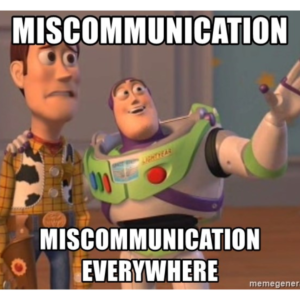Training sessions can be a valuable investment in your professional development. However, there are times when it feels like the hours spent in training, are simply wasted. But fear not! In this article, we’ll explore some signs that indicate you might be in danger of wasting your time during training. More importantly, we’ll provide you with practical advice on how to prevent this from happening. So, keep an eye out for these signs, and let’s make every minute of your training count!
Signs Your Training Might Be a Waste of Time
Sign #1: You don’t know why you are there
If the training content seems disconnected from your job responsibilities or career goals, it’s a clear sign that you might be wasting your time. Don’t hesitate to question the relevance of the training and communicate your concerns to your supervisor or the training coordinator. To prevent this from happening, make an effort to ask the supervisor or the training coordinator why you are being sent to this training and what your learning goals should be.
Sign #2: The training goals are vague
When the objectives and outcomes of the training are unclear or not properly defined, it becomes challenging to gauge the value it will bring to your professional growth. Before attending any training, ensure that the objectives align with your learning needs and goals.
Sign #3: The participants are all on different levels
If the training is designed to cater to a broad audience without considering individual skill levels or job requirements, it can leave you feeling overlooked and unchallenged. Seek out training opportunities that offer customization or personalized learning paths to make sure it’s a good fit for you. In your conversations with your boss, especially about performance, seek clarity on your strengths and opportunities for improvement, and communicate your learning goals to the people in charge of training so they can be sure you are being sent to the right training.
Sign #4: The facilitator is boring
Training sessions that lack interactivity and meaningful engagement can quickly become monotonous and unproductive. Look for training programs that encourage active participation, such as group discussions, hands-on exercises, or case studies. Active engagement will make the learning experience more enjoyable and effective. Don’t hesitate to comment on training evaluations that you prefer more interactive learning activities. One thing that you can do to engage yourself during the learning activity when you find the trainer or the resource person boring is to ask lots of questions. Sometimes it’s not just the learners that need engagement, sometimes the trainers too.
Sign #5: You can’t use it at work
Learning is most impactful when it can be directly applied to your work. If the training fails to provide practical examples or opportunities to practice new skills, it can feel disconnected from your day-to-day responsibilities. Seek out training programs that prioritize hands-on practice and offer real-world scenarios. If you see yourself trapped in a classroom where the learning facilitator doesn’t seem to provide practical examples, and opportunities to practice certain skills, ask away! Don’t allow yourself to get bored! Grab each opportunity to challenge the facilitator to give you practical examples and application opportunities within the classroom. If they do not come prepared, this will teach them to come better prepared next time.
Sign #6: Distractions Galore
In the era of constant connectivity, it’s easy to get distracted by devices and notifications during training sessions. Social media, emails, and personal messages can quickly steal your attention. To overcome this challenge, set aside your devices or activate “do not disturb” mode, and commit to staying focused on the training content.
Sign #7: You’re not interested enough
Sometimes, learners may attend training sessions with a disinterested or apathetic mindset, which diminishes their ability to absorb new knowledge and skills. To combat this challenge, approach each training session with a positive attitude and an open mind. Actively participate, ask questions, and seek opportunities to apply what you’re learning.
Sign #8: Miscommunications everywhere!
Supervisors may sometimes fail to communicate the purpose or expected outcomes of a training session to their employees. This lack of communication can lead to confusion and disengagement. As a learner, proactively reach out to your supervisor prior to attending the training to understand the training’s relevance and how it aligns with your professional growth.
Sign #9: Your Supervisor calls you a lot during training
During training, supervisors may inadvertently distract their employees by calling, emailing, or scheduling impromptu meetings. To mitigate this challenge, communicate your need for uninterrupted time during training sessions. Set clear boundaries and expectations with your supervisor, emphasizing the importance of focused learning during these sessions.
Preventing Wasted Time and Maximizing Your Training

You have as much at stake in your own training, and perhaps more than your supervisor and the training department. Taking responsibility for your own learning and growth, and taking accountability for how you will benefit from each learning opportunity will return you your investment of time and effort. Here are a few suggestions:
Know your needs
Before committing to any training, conduct a thorough self-assessment of your skills and knowledge gaps. Identify specific areas where you need improvement and look for training programs that directly address those needs. This ensures that your time and effort are invested wisely.

Set Clear Expectations
Clarify your expectations with your supervisor or the training coordinator. Discuss your desired learning outcomes and how you plan to apply the knowledge and skills gained from the training. Clear expectations will help you stay focused and motivated throughout the learning journey.

Get Recommendations
Ask colleagues or industry professionals for recommendations on training programs they found valuable and relevant. Their firsthand experiences can provide valuable insights and help you choose the right training opportunities.

Choose the right training providers
Before enrolling in a training program, research the reputation and track record of the training provider. Look for testimonials, reviews, or success stories from past participants to ensure that the training is of high quality and delivers on its promises.

Don’t get distracted
Create a focused learning environment by minimizing distractions caused by devices or other external factors. Set boundaries, silence notifications, and communicate your dedication to uninterrupted learning time. By eliminating distractions, you can fully immerse yourself in the training content.

Actively Participate
During the training, be an active participant. Engage in discussions, ask questions, and take notes. Actively participating not only enhances your learning experience but also shows your commitment to making the most of the training. I know, this is easier for some people than others, but this is the only way you can benefit from a training event. Be engaged.

Use What You Learn
Immediately after the training, create an action plan for implementing the knowledge and skills you acquired. Identify specific tasks or projects where you can apply what you’ve learned. The sooner you put your new knowledge into practice, the more likely it is to stick and have a meaningful impact on your work.

Seek Support and Feedback
Don’t hesitate to seek support from colleagues or supervisors as you implement what you’ve learned. Collaborate with others, ask for feedback, and learn from their experiences. This ongoing support will strengthen your learning journey and ensure continuous growth.

By recognizing the signs of wasted time during training and taking proactive steps to prevent it, you can make every training opportunity count. Assess your learning needs, set clear expectations, actively participate, and apply what you learn in practical ways. Remember, you are in control of your learning journey, and by being proactive and intentional, you can turn any training session into a valuable and productive experience. So, embrace the power of self-directed learning, and let each training opportunity propel you toward professional success!

















